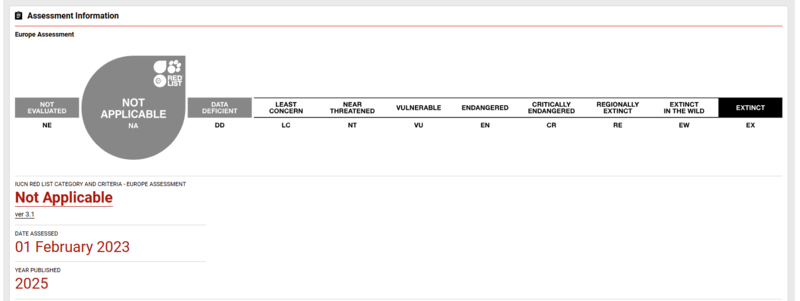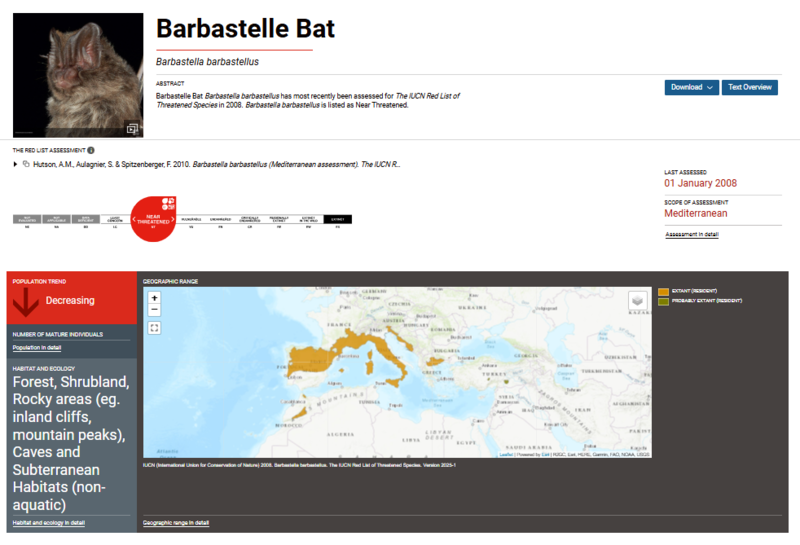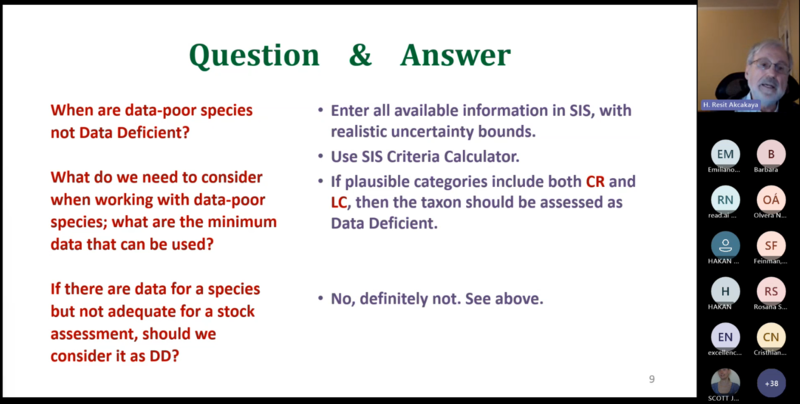What's New
Along with pages being regularly updated to reflect the new data available in each Red List update, new pages, tools and functionality are added to The IUCN Red List website at any time throughout the year. The most recent updates and additions to the Red List website are listed below.
For a list of previous updates and additions (since the start of 2020), click here.
Announcements and News |
|
| API v3 replaced by API v4 | IUCN Red List Updates |
New and updated pages |
|
| Regional assessment pages: regional categories | Spatial Data Downloads |
| Regional assessment pages: distribution maps | Summary Statistics |
New functionality |
|
| Search filters: European Union | |
Publications |
|
| Mapping Biodiversity Priorities | European Red List: Dragonflies & Damselflies |
Red List Tools, training and guidance documents |
|
| IUCN Red List webinars | |
Translations |
|
| Red List Guidelines | |
API v3 replaced by API v4
The v3 API has reached end of life and access to this will be removed shortly after the 2025-1 Red List update on the 27th March 2025. The last update to the underlying data for the v3 API was Red List version 2024-2. All users should now use the v4 API which can be accessed here.
Please note: no v3 API accounts will be migrated over to the v4 API so you will need to sign up for a new account to begin using this service.

European Red List: Dragonflies & Damselflies
 The publication Measuring the Pulse of European Biodiversity. European Red List of Dragonflies & Damselflies is a report of the updated status of Odonata species across Europe. The data for this report are available in the Red List Data Repository.
The publication Measuring the Pulse of European Biodiversity. European Red List of Dragonflies & Damselflies is a report of the updated status of Odonata species across Europe. The data for this report are available in the Red List Data Repository.
Search filters: European Union
 In March 2025, the IUCN Red List version 2025-1 introduced a new search filter on the Advanced Search page, allowing users to filter search results to show all taxa endemic to the European Union (EU) region. In March 2025, this included 27 EU countries: Austria, Belgium, Bulgaria, Croatia, Republic of Cyprus, Czech Republic, Denmark, Estonia, Finland, France, Germany, Greece, Hungary, Ireland, Italy, Latvia, Lithuania, Luxembourg, Malta, Netherlands, Poland, Portugal, Romania, Slovakia, Slovenia, Spain and Sweden.
In March 2025, the IUCN Red List version 2025-1 introduced a new search filter on the Advanced Search page, allowing users to filter search results to show all taxa endemic to the European Union (EU) region. In March 2025, this included 27 EU countries: Austria, Belgium, Bulgaria, Croatia, Republic of Cyprus, Czech Republic, Denmark, Estonia, Finland, France, Germany, Greece, Hungary, Ireland, Italy, Latvia, Lithuania, Luxembourg, Malta, Netherlands, Poland, Portugal, Romania, Slovakia, Slovenia, Spain and Sweden.
Regional assessment pages: regional categories
In March 2025, the Red List categories bar on the regional assessment pages was updated to show all regional Red List categories, including Regionally Extinct and Not Applicable.

Regional assessment pages: distribution maps
From March 2025, all regional assessments with distribution maps have included the map on the assessment page.

IUCN Red List Webinars
In December 2024, Resít Akçakaya returned to the IUCN Red List webinar series to answered more questions about the IUCN Red List. Amongst the topics discussed were the purpose of the IUCN Red List, the Extinction Probability tool, and using bioclimate models in Red List assessments. A recording of this webinar is available on the Red List Webinars page.

Mapping Biodiversity Priorities
 Spatial data and mapping can provide multiple benefits for biodiversity strategies and action planning at a national scale. However, few countries include any spatial data strategies in their National Biodiversity Strategies and Action Plans (NBSAPs). This publication (available here) shows how it is possible to use available spatial data to conduct a useful national assessment of biodiversity in a short space of time and with minimal resources.
Spatial data and mapping can provide multiple benefits for biodiversity strategies and action planning at a national scale. However, few countries include any spatial data strategies in their National Biodiversity Strategies and Action Plans (NBSAPs). This publication (available here) shows how it is possible to use available spatial data to conduct a useful national assessment of biodiversity in a short space of time and with minimal resources.
Summary Statistics page
 Each time The IUCN Red List is updated, the Summary Statistics page (in the Resources and Publications section) is also updated to provide statistics for the most recent version of the Red List. The Summary Statistics page also includes links to the automated statistics tables.
Each time The IUCN Red List is updated, the Summary Statistics page (in the Resources and Publications section) is also updated to provide statistics for the most recent version of the Red List. The Summary Statistics page also includes links to the automated statistics tables.
Spatial Data Download page
Each time The IUCN Red List is updated, the Spatial Data Download page (in the Resources and Publications section) is also updated to provide all the current map data for various groups of species (including polygon spatial data and point data, where available).
IUCN Red List updates
The IUCN Red List is updated regularly to refresh existing assessments and bring in species assessed for the first time. The most recent update was for version 2025-1 (released on 27 March 2025). The media release for this and all past updates is available on the IUCN Red List Media Releases page and the schedule for future updates is shown on the Planned Red List Updates page.

Red List Guidelines
 The Portuguese version of the Guidelines for using the IUCN Red List Categories and Criteria is now updated to version 16. In March 2025, this updated document was made available here.
The Portuguese version of the Guidelines for using the IUCN Red List Categories and Criteria is now updated to version 16. In March 2025, this updated document was made available here.


